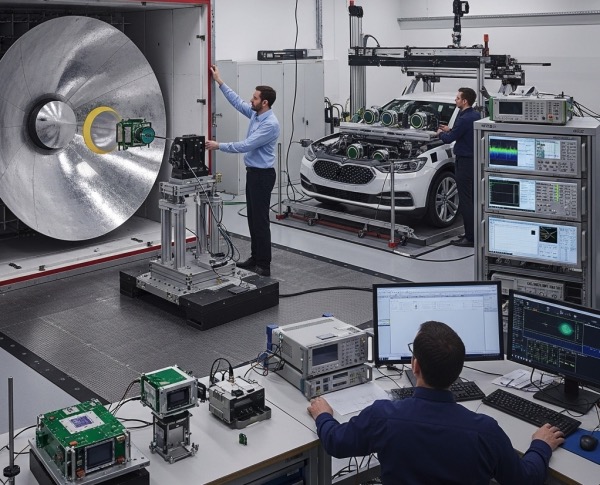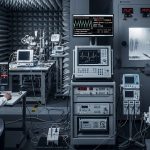The automotive radar market is experiencing explosive growth, projected to reach $22.8-56.9 billion by 2030-2033, with a compound annual growth rate of 23-27.4%. This unprecedented expansion is driven by mandatory Advanced Driver Assistance Systems (ADAS), the push toward autonomous vehicles, and regulatory mandates including Europe’s Vehicle General Safety Regulations and NHTSA requirements in the US.
However, this opportunity comes with significant testing challenges that can make or break a supplier’s market position. The transition from traditional 24 GHz systems to 77-79 GHz 4D imaging radar, combined with stringent automotive EMC requirements, demands sophisticated test equipment investments that 70% of automotive suppliers underestimate during their development planning.
Understanding the true cost and technical requirements for automotive radar testing—from RF characterization to regulatory compliance—is crucial for engineering teams, product managers, and executives planning their market entry strategy.
Regulatory Landscape: What Drives Testing Requirements
Global Automotive Radar Regulations
The automotive radar industry operates under multiple overlapping regulatory frameworks that directly impact testing requirements and equipment selection.
FCC and ETSI Requirements:
- 77-81 GHz band allocation: Specific power spectral density limits and unwanted emission requirements
- EIRP limitations: Typically 55 dBm maximum for long-range radar applications
- Frequency stability: ±50 ppm maximum deviation across temperature and aging
- Spurious emission compliance: -30 dBc limit outside allocated bands
ECE Regulation 79 (Europe):
- Mandatory for all vehicles with radar-based safety systems
- References CISPR 25 and ISO 11452 for EMC testing requirements
- Specific antenna pattern and detection performance criteria
Automotive EMC Standards Impact
CISPR 25 (Component-Level EMC):
- Radiated emissions: 150 kHz to 18 GHz measurement range
- Conducted emissions on power and signal lines
- Immunity requirements for radar coexistence with other vehicle systems
ISO 11452-2 (Component Immunity):
- 200 MHz to 18 GHz radiated immunity testing
- Field strength levels up to 200 V/m for critical safety systems
- Required for all safety-critical radar components
Essential Test Equipment by Application
Vector Network Analyzers ($80,000 – $800,000)
VNAs form the backbone of automotive radar testing, providing critical S-parameter measurements for antenna characterization, component validation, and system integration.
Mid-Range Solutions ($80,000-$200,000):
Keysight E5080B ENA Series:
- Frequency range: 10 MHz to 53 GHz (covers 77-79 GHz with external mixers)
- Dynamic range: >130 dB at 77 GHz
- Power range: -45 to +20 dBm
- Key features: Integrated time domain analysis, mixer characterization capability
- Pricing: $120,000-$180,000 with mmWave extensions
Rohde & Schwarz ZNB Series:
- Frequency coverage: 9 kHz to 43.5 GHz
- Phase noise: <-105 dBc/Hz at 10 kHz offset
- Measurement speed: 50 μs/point for production testing
- Pricing: $100,000-$160,000 for automotive radar configurations
High-End Solutions ($300,000-$800,000):
Keysight PNA-X N5247B:
- Frequency range: 10 MHz to 67 GHz
- Built-in signal sources and receivers for complex measurements
- Non-linear measurements including AM/PM, gain compression
- Automotive radar measurement applications for FMCW waveform analysis
- Pricing: $400,000-$600,000 with automotive radar options
Rohde & Schwarz ZNA67:
- Frequency coverage: 10 MHz to 67 GHz
- Four internal phase-coherent sources
- Touch-only operation with DUT-centric workflow
- Exceptional accuracy: 0.006 dB magnitude, 0.06° phase at 77 GHz
- Pricing: $500,000-$800,000 for full 4-port configuration
Automotive Radar Signal Analyzers ($150,000 – $500,000)
Keysight E4440A PSA Series:
- Frequency range: 3 Hz to 110 GHz with external mixers
- FMCW radar waveform analysis capability
- Built-in automotive radar measurement applications
- Chirp analysis and modulation quality measurements
- Pricing: $200,000-$350,000 for automotive radar configuration
Rohde & Schwarz FSW Signal and Spectrum Analyzer:
- Frequency coverage: 2 Hz to 85 GHz
- Analysis bandwidth: up to 5 GHz for wideband FMCW signals
- Real-time automotive radar signal analysis
- Advanced trigger capabilities for chirp sequences
- Pricing: $250,000-$450,000 with automotive radar options
Compact Antenna Test Range (CATR) Systems ($800,000 – $3,000,000)
CATR systems provide controlled far-field measurement environments essential for automotive radar antenna pattern characterization and regulatory compliance testing.
Mid-Size CATR Solutions ($800,000-$1,500,000):
Keysight AR8700C/F9652A:
- Quiet zone: 40 cm diameter
- Frequency range: 24-110 GHz
- Positioning accuracy: ±0.1° in azimuth/elevation
- Includes: Parabolic reflector, feed assembly, DUT positioner, control software
- Applications: Design verification, functional testing, antenna pattern measurements
- Pricing: $900,000-$1,200,000 for automotive radar configuration
Rohde & Schwarz ATS800B:
- Compact benchtop design for smaller components
- Frequency coverage: 18-87 GHz
- High-precision reflector for >50 dB quiet zone accuracy
- Integrated with R&S test equipment for streamlined measurements
- Pricing: $600,000-$900,000 complete system
Large CATR Systems ($1,500,000-$3,000,000):
Full Vehicle Testing Solutions:
- Quiet zone: 2-4 meter diameter for complete vehicle testing
- Multi-axis positioning systems for complex measurement scenarios
- Environmental control for temperature and humidity stability
- Integrated shielding for automotive EMC compliance
- Custom integration with automotive test standards
Key Technical Specifications Required:
- Quiet zone uniformity: ±1 dB amplitude, ±10° phase ripple
- Cross-polarization isolation: >30 dB minimum
- Frequency range: 76-81 GHz minimum, 24-87 GHz preferred
- Positioning accuracy: ±0.05° for automotive radar applications
Environmental Test Chambers ($75,000 – $400,000)
Automotive radar systems must operate reliably across extreme temperature ranges, humidity conditions, and vibration profiles defined in automotive standards.
Temperature/Humidity Chambers ($75,000-$150,000):
- Temperature range: -40°C to +125°C (automotive operating range)
- Humidity range: 5% to 95% RH, non-condensing
- Temperature uniformity: ±2°C within test volume
- Compliance with ISO 16750 automotive environmental standards
Combined Environmental Systems ($200,000-$400,000):
- Integrated temperature, humidity, vibration, and altitude simulation
- Salt spray and corrosion testing capability per ISO 9227
- Thermal shock testing: -40°C to +125°C transitions
- Vibration profiles per ISO 16750-3 (random and sine sweep)
Over-the-Air (OTA) Testing Requirements
Regulatory Compliance Testing
FCC Equipment Authorization (US):
- EIRP measurements across antenna patterns
- Spurious emission testing outside 76-81 GHz band
- Frequency stability across temperature and aging
- Testing cost: $50,000-$150,000 for full certification
ETSI Compliance (Europe):
- EN 302 858 harmonized standard compliance
- Power spectral density measurements
- Antenna pattern verification for interference analysis
- Testing cost: €40,000-€120,000 for complete authorization
Performance Verification Testing
Range and Resolution Measurements:
- Target detection at ranges from 0.2m to 300m
- Range resolution: typically 0.1-0.2m for automotive applications
- Velocity resolution: 0.1-0.5 m/s depending on application
- Angular resolution: 1-5° depending on antenna design
Multi-Target Scenarios:
- Simultaneous tracking of multiple objects
- Cross-range resolution for target separation
- Performance under various weather conditions
- Interference mitigation with other radar systems
Market Leaders and Competitive Analysis
Test Equipment Vendors
Tier 1 – Premium Solutions:
Keysight Technologies:
- Market position: Leading automotive radar test solutions
- Comprehensive portfolio from component to system level
- Strong software ecosystem for automated testing
- Price premium: 15-25% above competitors
- Key differentiators: Advanced FMCW analysis, integrated CATR solutions
Rohde & Schwarz:
- Market position: Strong in European automotive market
- Excellent RF performance and measurement accuracy
- DUT-centric user interfaces reduce setup complexity
- Competitive pricing with high-end features
- Key differentiators: Automotive-specific measurement applications
Tier 2 – Cost-Effective Solutions:
Anritsu:
- Focus on compact, portable test solutions
- Strong in production test applications
- Competitive pricing for basic measurements
- Limited high-frequency capabilities above 70 GHz
Guzik Technical Enterprises:
- Specialized FMCW radar test solutions
- Modular architecture for flexible configurations
- Cost-effective for specific automotive radar applications
Automotive Radar IC Suppliers
Technology Leaders:
- NXP Semiconductors: S32R automotive radar processors
- Texas Instruments: AWR series 77-79 GHz sensors
- Infineon Technologies: 77/79 GHz radar ICs
- Analog Devices: Integrated FMCW radar solutions
Testing Requirements by Supplier:
- Different suppliers require specific test protocols
- Wafer-level vs. packaged device testing considerations
- Production test time optimization requirements
- Statistical process control integration
Budget Planning and ROI Analysis
Equipment vs. Outsourcing Decision Matrix
Choose In-House Testing When:
- Developing more than 3-5 radar variants annually
- Iterative design cycles require frequent validation
- Proprietary algorithms need confidential testing
- Long-term automotive radar product pipeline (5+ years)
- Production volume exceeds 100,000 units annually
Choose Outsourcing When:
- Limited radar development volume (1-2 products annually)
- Specialized compliance testing beyond core competencies
- Capital constraints limit equipment investment
- Time-to-market prioritizes speed over long-term cost optimization
Investment Prioritization Framework
Phase 1 – Basic Capability ($200,000-$500,000):
- Mid-range VNA for S-parameter measurements
- Signal analyzer for FMCW waveform analysis
- Basic environmental chambers for temperature testing
- EMC pre-compliance test equipment
Phase 2 – Advanced Development ($800,000-$1,500,000):
- High-end VNA with automotive radar applications
- Compact CATR system for antenna measurements
- Comprehensive environmental test capability
- OTA test chamber for interference analysis
Phase 3 – Production/Compliance ($1,500,000-$3,000,000):
- Full-scale CATR system for complete vehicle testing
- Automated test systems for high-volume production
- Regulatory compliance test capability
- Advanced interference and coexistence testing
ROI Calculation Framework
Equipment Lifecycle Analysis:
- Typical equipment lifecycle: 7-10 years for automotive applications
- Annual maintenance: 8-12% of purchase price
- Technology refresh cycle: 5-7 years for leading-edge automotive radar
- Calibration costs: $15,000-$50,000 annually for complete test lab
Cost Comparison – In-House vs. Outsourced:
In-House Testing (Break-even: 8-12 products annually):
- Initial investment: $1,000,000-$2,500,000
- Annual operating costs: $200,000-$500,000
- Cost per test cycle: $15,000-$25,000 after break-even
- Control and IP protection benefits
Outsourced Testing:
- No initial investment required
- Cost per test cycle: $75,000-$150,000 for complete automotive radar validation
- Regulatory compliance testing: $100,000-$200,000 per product
- Limited control over test schedules and priorities
Technical Specifications and Standards Compliance
Critical Test Parameters
RF Performance Measurements:
- Transmit power: EIRP verification across antenna patterns
- Frequency accuracy: ±50 ppm across temperature and aging
- Chirp linearity: <2% RMS error for FMCW waveforms
- Phase noise: <-80 dBc/Hz at 10 kHz offset for 77 GHz systems
- Spurious emissions: <-30 dBc outside allocated 77-81 GHz band
Antenna Characterization:
- Gain pattern: 3D antenna pattern measurements
- Beamwidth: Half-power beamwidth (HPBW) verification
- Cross-polarization: >25 dB isolation requirement
- Side lobe levels: <-20 dB for regulatory compliance
- Return loss: >15 dB across operational bandwidth
System Performance Validation:
- Detection range: Verification across 0.2m to 300m
- Range resolution: 0.1-0.2m for high-resolution applications
- Velocity accuracy: ±0.1 m/s for ADAS applications
- Angular accuracy: ±1° for precise object localization
- Multi-target capability: Simultaneous tracking validation
Strategic Recommendations
For most automotive radar suppliers, a phased investment approach optimizes cost and risk. Begin with essential RF characterization capabilities while outsourcing specialized regulatory testing, then expand based on product portfolio and volume projections.
Recommended Investment Sequence:
- VNA for component and antenna characterization (Priority 1)
- Signal analyzer for FMCW waveform validation (Priority 2)
- Environmental testing for automotive qualification (Priority 3)
- CATR system for advanced antenna measurements (Priority 4)
Key Success Factors:
- Early engagement with automotive OEM test requirements
- Investment in test automation for production scalability
- Compliance with automotive quality standards (ISO 26262, IATF 16949)
- Integration with existing automotive development workflows
The total investment for a comprehensive automotive radar testing capability typically ranges from $1,500,000-$3,000,000, with annual operating costs of $300,000-$600,000. This investment becomes cost-neutral within 24-36 months for companies with active automotive radar development programs.
The automotive radar testing market rewards early investment in comprehensive test capabilities. Companies that establish robust testing infrastructure position themselves advantageously for the autonomous vehicle revolution, while those relying solely on outsourced testing face schedule risks and limited development agility in this rapidly evolving market.

